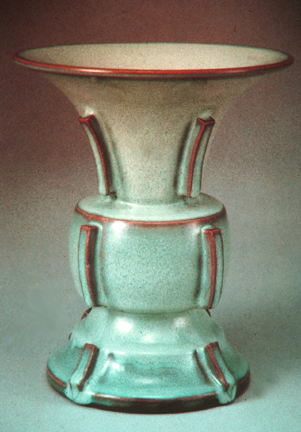
SONG JUN WARE VASE, STONEWARE,
China, 960-1127 CE
ART 198 - HISTORY OF WORLD CERAMICS
| Jun ware of the Song dynasty is often glazed with a thick application of a turquoise to green glaze made by the addition of copper oxide to the glaze. The glaze had a tendency to run as can be seen on this example. As the glaze moves, it pulls away from raised edges, revealing the color of the clay beneath. This vase was probably thrown in three sections and assembled. The appliques of square rods of clay were then added. Shapes such as this were clearly based on bronze prototypes, and were often made using the same molds. Rather than rely on painted decoration, the Song potters more often allowed the glaze and the clay to provide interest. Jun glazes are called 'opalescent.' In ceramic terms this means that the glaze is suffused with thousands of tiny air bubbles caused by release of gases during the glaze melt. This results in the glaze capturing light and reflecting it, making for a rich glaze surface. Pieces such as this were fired in chambered kilns such as the one illustrated in the diagram in another slide. Glazed ware presents different challenges in firing than unglazed ware. The pieces must be separated in order to prevent the glaze from sticking pieces together as the glazes melt and touch. Song potters used saggars, clay boxes to contain such vases. The saggar boxes are illustrated in the kiln diagram. These boxes served two purposes: first, they protected the glazed pieces within from the action of flying wood ash in the kiln, and second, they kept pieces separate so that they would not adhere to each other. Sometimes, of course, the glazed piece within the saggar would touch the saggar wall, and the piece would be ruined as it was permanently attached to the saggar. | SONG JUN WARE VASE, STONEWARE, China, 960-1127 CE |
|
|